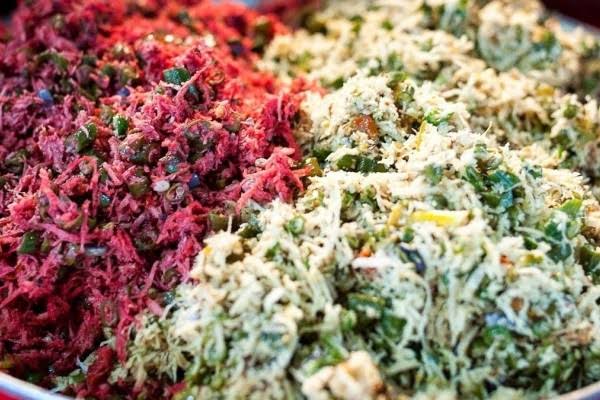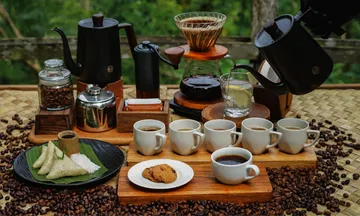Lawar is an iconic dish from Bali, offering a deep insight into the island’s rich cultural and religious heritage. A traditional Balinese delicacy, lawar is far more than just food—it’s a representation of harmony, spirituality, and community. Often prepared for religious ceremonies, social gatherings, or family celebrations, lawar holds significant meaning in the daily lives of Balinese people. Its unique combination of fresh ingredients, local herbs, and spices, along with its diverse variations, make it one of Bali’s most revered dishes.
The Historical Significance of Lawar
The origins of lawar trace back to the 15th century, deeply intertwined with Bali’s Hindu practices. Lawar is believed to have emerged from the Bhairawa sect of Hinduism, which was present on the island at the time. Over centuries, lawar has been prepared not only as food but also as an offering in sacred religious rituals. It symbolizes the balance between humans, nature, and the divine, serving as a key element in the island’s religious life.
The dish’s connection to spiritual practices is evident. Lawar was initially used as an offering in the Panca Yadnya, a series of Hindu ceremonies that involve sacrifices to the gods, the ancestors, and nature. Even today, it is an essential part of Balinese ceremonial food offerings.
Different Types of Lawar
Lawar is a versatile dish, with many regional variations and types. Each type of lawar reflects the diversity of Bali’s culture and cuisine. Here are some of the most popular types:
- Lawar Merah (Red Lawar)
This version of lawar is characterized by the inclusion of animal blood, typically from a pig or chicken. The blood gives the dish a rich, red color and imparts a strong flavor. It is often served during large feasts or ceremonies. - Lawar Putih (White Lawar)
Unlike the red version, lawar putih does not use animal blood. Instead, it is made with finely chopped vegetables, such as young jackfruit or long beans, and mixed with grated coconut. The result is a lighter, milder dish often enjoyed by those who avoid animal blood. - Lawar Ayam (Chicken Lawar)
Lawar ayam is a variation made with chicken, which is commonly prepared in both ceremonial and non-ceremonial settings. The chicken is often combined with fresh herbs and spices to give it a flavorful, aromatic base. This version of lawar can be found in restaurants and homes throughout Bali. - Lawar Babi (Pork Lawar)
Popular in Bali’s Hindu ceremonies, this version of lawar uses pork, often combined with spices and grated coconut, reflecting the island’s local traditions. It is a dish that carries deep cultural significance. - Lawar Padamare
A mixed version of lawar, lawar padamare brings together several types of lawar ingredients for a more complex and rich flavor profile. This variation is less common but prized for its variety and intricate flavors.
Key Ingredients in Lawar
The making of lawar requires a blend of fresh local ingredients, each contributing its own flavor and texture to the dish. Here are the key ingredients used in most versions of lawar:
- Vegetables: Long beans, young jackfruit, and banana blossoms are commonly used in the dish, providing a crunchy texture and a natural sweetness.
- Meat: Chicken or pork is used as the primary protein in the dish, though some variations include fish or other meats.
- Spices: Aromatic spices such as garlic, shallots, turmeric, ginger, and lemongrass are ground and mixed into the dish to create its characteristic flavor.
- Coconut: Grated coconut is a staple ingredient, giving lawar its creamy texture and added richness.
- Animal Blood: In some versions, such as lawar merah, blood from pigs or chickens is added to the mixture, enhancing both the color and depth of flavor.
- Herbs: Fresh herbs like basil, lime leaves, and even bitter leaves add a refreshing element to the dish.
The Ritual of Making Lawar
Making lawar is a social and ceremonial activity. While each family or village may have its own variation, the core principles of preparation remain the same. Traditionally, the preparation of lawar is done with great care and respect.
Steps to Make Lawar
- Preparation of Ingredients: First, the vegetables such as long beans and young jackfruit are boiled until tender. Meat (usually chicken or pork) is diced or ground, and the spices are finely chopped or ground into a paste.
- Mixing: The cooked vegetables, meat, and grated coconut are mixed together in a large bowl. The spices are then added, followed by blood (for red lawar) or additional seasonings for white lawar.
- Serving: The dish is served fresh, often with steamed rice, and sometimes accompanied by other ceremonial dishes like satay or rice cakes. It is common to see lawar served at Balinese feasts and ceremonies, symbolizing unity, fertility, and spiritual renewal.
Lawar’s Cultural and Spiritual Meaning
In Balinese culture, food holds deep symbolic meanings. Lawar, in particular, is a dish that embodies the Balinese philosophy of Tri Hita Karana, the belief that harmony must be maintained between humans, nature, and the divine. The act of preparing and sharing lawar is seen as a way of reinforcing these relationships.
Beyond its spiritual significance, lawar is also a symbol of communal cooperation. It is traditionally made in large quantities, often prepared in groups for celebrations or ceremonies. This process reinforces the sense of togetherness and community, as family members or neighbors work side by side to prepare the dish.
Lawar is a dish that encapsulates the essence of Bali—its spiritual depth, rich history, and cultural heritage. Whether served as part of a religious ceremony or enjoyed as a daily meal, lawar offers a taste of the island’s deep traditions and values. For those visiting Bali, experiencing this dish is not just about tasting local food; it’s about connecting with the island’s soul and understanding the way food reflects the culture and spirituality of its people. (BT)





